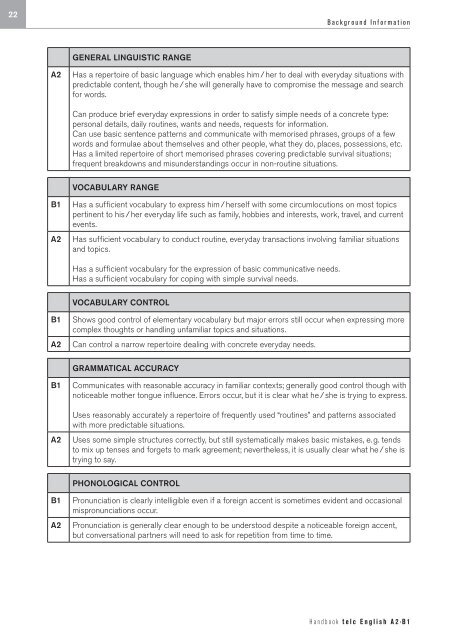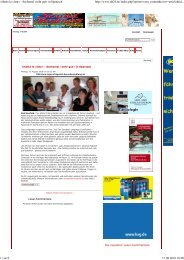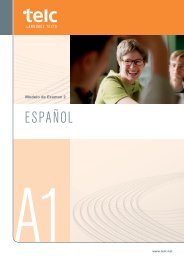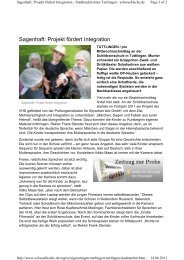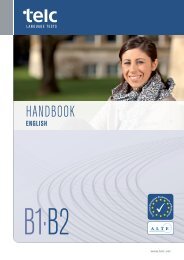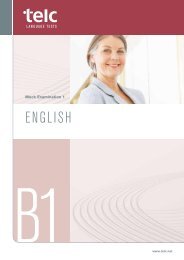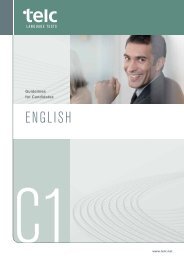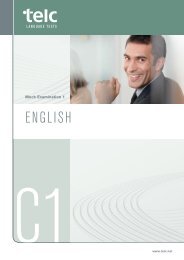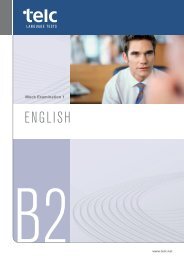Download Handbook (PDF, 4,3 MB) - telc GmbH
Download Handbook (PDF, 4,3 MB) - telc GmbH
Download Handbook (PDF, 4,3 MB) - telc GmbH
You also want an ePaper? Increase the reach of your titles
YUMPU automatically turns print PDFs into web optimized ePapers that Google loves.
22<br />
GENERAL LINGUISTIC RANGE<br />
Background Information<br />
A2 Has a repertoire of basic language which enables him / her to deal with everyday situations with<br />
predictable content, though he / she will generally have to compromise the message and search<br />
for words.<br />
Can produce brief everyday expressions in order to satisfy simple needs of a concrete type:<br />
personal details, daily routines, wants and needs, requests for information.<br />
Can use basic sentence patterns and communicate with memorised phrases, groups of a few<br />
words and formulae about themselves and other people, what they do, places, possessions, etc.<br />
Has a limited repertoire of short memorised phrases covering predictable survival situations;<br />
frequent breakdowns and misunderstandings occur in non-routine situations.<br />
VoCAbULARY RANGE<br />
b1 Has a sufficient vocabulary to express him / herself with some circumlocutions on most topics<br />
pertinent to his / her everyday life such as family, hobbies and interests, work, travel, and current<br />
events.<br />
A2 Has sufficient vocabulary to conduct routine, everyday transactions involving familiar situations<br />
and topics.<br />
Has a sufficient vocabulary for the expression of basic communicative needs.<br />
Has a sufficient vocabulary for coping with simple survival needs.<br />
VoCAbULARY CoNTRoL<br />
b1 Shows good control of elementary vocabulary but major errors still occur when expressing more<br />
complex thoughts or handling unfamiliar topics and situations.<br />
A2 Can control a narrow repertoire dealing with concrete everyday needs.<br />
GRAMMATICAL ACCURACY<br />
b1 Communicates with reasonable accuracy in familiar contexts; generally good control though with<br />
noticeable mother tongue influence. Errors occur, but it is clear what he / she is trying to express.<br />
Uses reasonably accurately a repertoire of frequently used “routines” and patterns associated<br />
with more predictable situations.<br />
A2 Uses some simple structures correctly, but still systematically makes basic mistakes, e. g. tends<br />
to mix up tenses and forgets to mark agreement; nevertheless, it is usually clear what he / she is<br />
trying to say.<br />
PHoNoLoGICAL CoNTRoL<br />
b1 Pronunciation is clearly intelligible even if a foreign accent is sometimes evident and occasional<br />
mispronunciations occur.<br />
A2 Pronunciation is generally clear enough to be understood despite a noticeable foreign accent,<br />
but conversational partners will need to ask for repetition from time to time.<br />
<strong>Handbook</strong> <strong>telc</strong> English A2·B1


